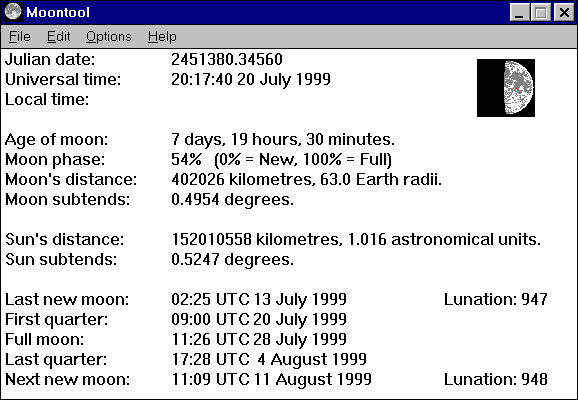Moontool for Windows is a 16-bit Microsoft Windows application that calculates the phase of the Moon at either the current time or at any user-specified time and displays a picture of the Moon at the correct phase, either as an icon or in an open window.
 When the Moontool window is open, it displays comprehensive
information about the Moon, as shown at the right.
When the Moontool window is open, it displays comprehensive
information about the Moon, as shown at the right.
When closed to an icon, Moontool displays the image of the Moon at the current phase, subtitled with the age of the Moon in days and hours (or hours and minutes when the Moon is less than one day old). If Moontool is launched from the "load=" statement in WIN.INI, it starts as an icon, permitting you to include the Moon as a permanent embellishment of your Windows desktop.
Moontool allows the information displayed in the open window to be copied to the clipboard as a bitmap, permitting you to paste it into another document.
In addition to displaying the Moon at the current time, Moontool can calculate the appearance of the Moon at any user-specified date and time. Two dialogues permit entering date and time either as a conventional Universal time (year, month, day, hours, minutes, and seconds) or as a Julian date. These dialogues perform instantaneous conversion between Universal time and Julian date, serving thus as a Julian date calculator, handy by itself to astronomers. You can animate the display of the Moon by placing Moontool into "Fast mode", showing the progression of phases at the rate of one day every few seconds.
Moontool's ability to display the Moon at any date in history lets you
quickly answer questions such as that posed in the April 1992 issue of
Sky and Telescope
(page 437): did Paul Revere's midnight ride really
occur under the full Moon, or did Longfellow add the Moon to his poem
purely for atmosphere? Firing up Moontool and entering the time and
date of Revere's ride: 05:00:00 UTC April 19th, 1775, we find that the
Moon was 87% full that night, waning from the last full Moon at 21:53
UTC on April 15th, 1775. Moontool tells us that the Moon was indeed
close to full that night, confirming Revere's own recollection that
"the Moon shone bright".
The source and executable code for Moontool are in the public domain. You are free to use it in any manner you wish without permission, restriction, attribution, or compensation.
SET TZ=tzn[+|-]hh[:mm[:ss]][dzn]where:
TZ specifications for time zones in the 48 contiguous United States are:
- tzn
- Three character abbreviation for the time zone name.
- hh
- The difference in hours between GMT and the local time. A leading '+' or '-' sign is optional.
- mm
- Optional minutes difference.
- ss
- Optional seconds difference.
- dzn
- Optional three character abbreviation for the time zone name during daylight savings time (if used in this locality).
| Zone | SET TZ= |
|---|---|
| Eastern | EST5EDT |
| Central | CST6CDT |
| Mountain | MST7MDT |
| Pacific | PST8PDT |
If no TZ specification is present, Moontool issues a warning alert when launched and uses the system default of the US Pacific time zone. the relationship between the local time provided by the system clock on MS-DOS and Universal Time (or Greenwich Mean Time).
Experienced C programmers who wish to modify this program or simply read the code to see how it works may download the source code. You're welcome to use this source code in any way you like, but absolutely no support is provided--you're entirely on your own.
In 1988 and 1989 Ron Hitchens contributed additional features to the Sun version of the program, including the shaded Moon images which were drawn by Joe Hitchens on an Amiga computer.
In December of 1991 I implemented Moontool under the X Window system using the OpenLook toolkit. That version formed the starting point for this Microsoft Windows Moontool which was completed in March of 1992.
In March of 1999 I made a 32-bit version including a help file and this 16-bit version was updated to incorporate several minor bug fixes uncovered in testing its 32-bit descendent.
These references can be obtained from Willmann-Bell, P.O. Box 35025, Richmond, VA 23235, USA. Phone: (804) 320-7016. In addition to their own publications, they stock most of the standard references for mathematical and positional astronomy.